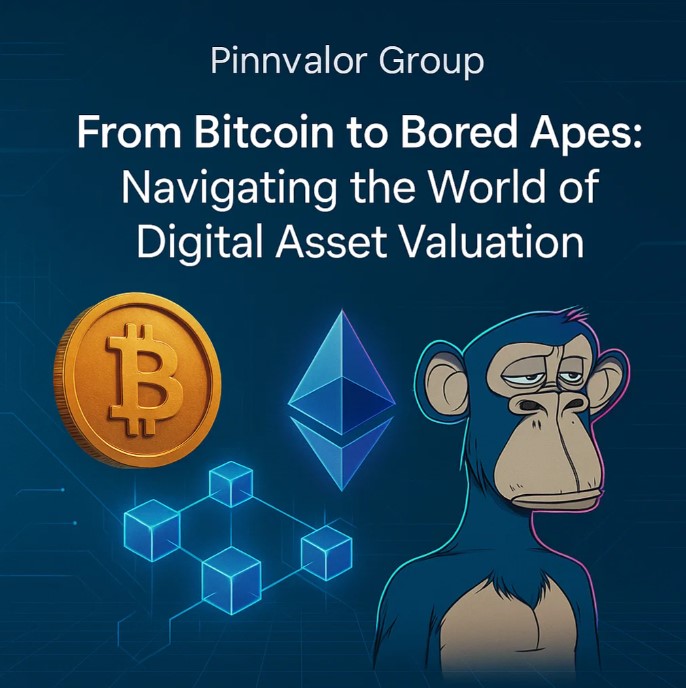
From Bitcoin to Bored Apes: Navigating the World of Digital Asset Valuation
The digital economy has unlocked a new frontier of assets, reshaping how we perceive value, ownership, and investment. From Bitcoin’s pioneering role in cryptocurrencies to the cultural phenomenon of Bored Ape NFTs, this guide explains what drives value in digital assets and how to think about valuation in a fast-moving market.
What truly makes a Bitcoin worth thousands—or a digital ape worth millions?
Whether it’s Bitcoin as digital gold or Bored Apes as digital identity, understanding value is key to navigating tomorrow’s economy.
The Rise of Digital Assets
A short history and the major categories you’ll encounter.
Cryptocurrencies
Bitcoin, introduced in 2009, challenged traditional finance by enabling decentralized, peer-to-peer money. Since then, thousands of cryptocurrencies have appeared with diverse use cases—Ethereum for smart contracts, payment-focused tokens, privacy coins, stablecoins, and more.
NFTs (Non-Fungible Tokens)
NFTs brought uniqueness to on-chain ownership. They can tokenize art, music, collectibles, virtual land, and identity. Collections like the Bored Ape Yacht Club (BAYC) blend art, community membership, and brand collaborations to create cultural and financial value.
What Drives Value in Digital Assets?
Several overlapping factors determine why one asset commands a high price while another does not.
- Scarcity & Supply: Bitcoin’s capped supply (21 million) creates digital scarcity similar to gold. NFTs are often unique or limited editions.
- Utility: Assets that power real applications—DeFi, smart contracts, in-game mechanics, or staking—carry intrinsic utility value.
- Community & Culture: Engaged communities can amplify demand (memecoins, social clubs, and NFT communities).
- Speculation & Sentiment: Hype, FOMO, and social media-driven narratives cause rapid price swings.
- Institutional Adoption & Legitimacy: ETFs, custody services, corporate treasuries, and regulated marketplaces increase liquidity and trust.
Valuation Frameworks
Digital assets don’t fit neatly into traditional valuation models, but this set of frameworks helps build a reasoned approach.
Network Value-to-Transactions (NVT) Ratio
For cryptocurrencies: NVT compares market capitalization to on-chain transaction volume—an analogue to price-to-earnings for stocks. A high NVT suggests a fair or overvalued token relative to activity.
Utility-Based Models
Estimate asset value based on platform usage: fees, staking rewards, token burn mechanics, or revenue capture from apps running on the network.
Comparable Sales (for NFTs)
NFT valuation often starts with recent sale prices of similar pieces (floor price, rarity-adjusted comparables) and adjusts for provenance, on-chain history, and cultural relevance.
Cultural & Brand Value
Intangible but powerful: celebrity endorsements, brand partnerships, industry press, and exclusivity can dramatically lift price beyond purely technical metrics.
Risks and Challenges
Investing or valuing digital assets comes with unique risks you must consider.
- Volatility: Prices can move violently in short timeframes.
- Regulatory Uncertainty: Classification, taxation, and compliance rules are still evolving worldwide.
- Speculative Bubbles: Projects driven primarily by hype are susceptible to crashes.
- Security Risks: Smart contract bugs, exchange hacks, and rug pulls remain real threats.
Quick tip
Do your own research (DYOR): combine on-chain metrics, whitepaper reading, team audits, and community signals before allocating capital.

Bringing It Together — A Practical Checklist
When you evaluate any digital asset, run it through this checklist:
- Supply mechanics: Is it inflationary, deflationary, capped, or minted forever?
- Real utility: Does the asset power applications or just trade on sentiment?
- On-chain activity: Transactions, active addresses, developer commits, and integrations.
- Community strength: Engagement, governance participation, and social sentiment.
- Regulatory profile: Is the asset likely to face restrictions or be considered a security?
- Security & audits: Are smart contracts audited and well-tested?
Looking Ahead
Digital assets are early-stage technology — comparable to the internet in the 1990s. Some projects will fail, others will form the backbone of the future digital economy. By understanding scarcity, utility, community, and cultural significance, you’ll be better equipped to value and navigate this space.
Conclusion
From Bitcoin’s narrative as "digital gold" to Bored Apes’ role in digital identity and community, the value of digital assets is multifaceted. There is no single perfect valuation method; instead, combine quantitative on-chain analysis with qualitative cultural and product insights to form a coherent view.